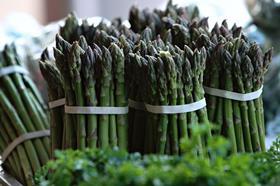
Negative economic and weather influences will lead to a contraction in Peruvian asparagus production and fresh exports this year.
Output in 2013 is expected to be down on last year’s 23m-carton total, local supplier-distributors have told Americafruit, as productivity and profitability continue to hamper the industry.
“Overall we’re seeing a fall in the number of cartons of asparagus being exported over the last year or so – the 2013 numbers so far are certainly down on the previous year,” explained Mike Soulsby of Delica South America.
The downturn is attributable to ageing plantations, a loss of planted area, higher costs and inclement weather, as well as unusually high prices for frozen asparagus over the last 12 months.
“The average age of asparagus plantations is increasing and productivity is reducing,” explained a spokesperson for Camposol, Peru’s biggest agriculture company.
“There are also many plantations which are being replaced with crops like table grapes, avocados, citrus or blueberries which are more profitable than asparagus. Added to that, labour, water and machinery costs have risen by up to 30 per cent in the last two years.”
Camposol claims prices for Peruvian asparagus will have to rise in the coming seasons, as markets must adapt to the reality of production costs in Peru and work with their suppliers to ensure a fair and sustainable business.
So far, Delica South America says most major market have been able to pay the higher prices. “Peru still has a luxurious position as almost the only global supplier of asparagus at certain times of the year,” Soulsby pointed out.
“Countries such as Mexico are trying to steal more and more of the pie, but they do not have the year-round growing capability that Peru does or the same climatic stability.”
Although markets like Japan or Australia offer good prices, Camposol admits that the logistics are complicated because of the distance and availability. Although the firm notes that Asia is “always very attractive” in terms of price.
Indeed, Soulsby points out that access to China for Peruvian asparagus has been granted, and New Zealand is hopefully not far off approval either.
Nevertheless, both companies agree that North America will remain the major market for Peruvian asparagus in the future due to the relatively short distance from Peru, the logistics availability and consumption levels.
“The industry is still hugely reliant on the North American market, with around 60-70 per cent of total volume being channelled into US,” Soulsby said.
However, opportunities are still available to grow mature markets, according to Camposol. “Europe has big potential to develop,” the spokesperson said. “The UK is the main country with high demand for green asparagus, while Germany is the biggest market for white asparagus.”



